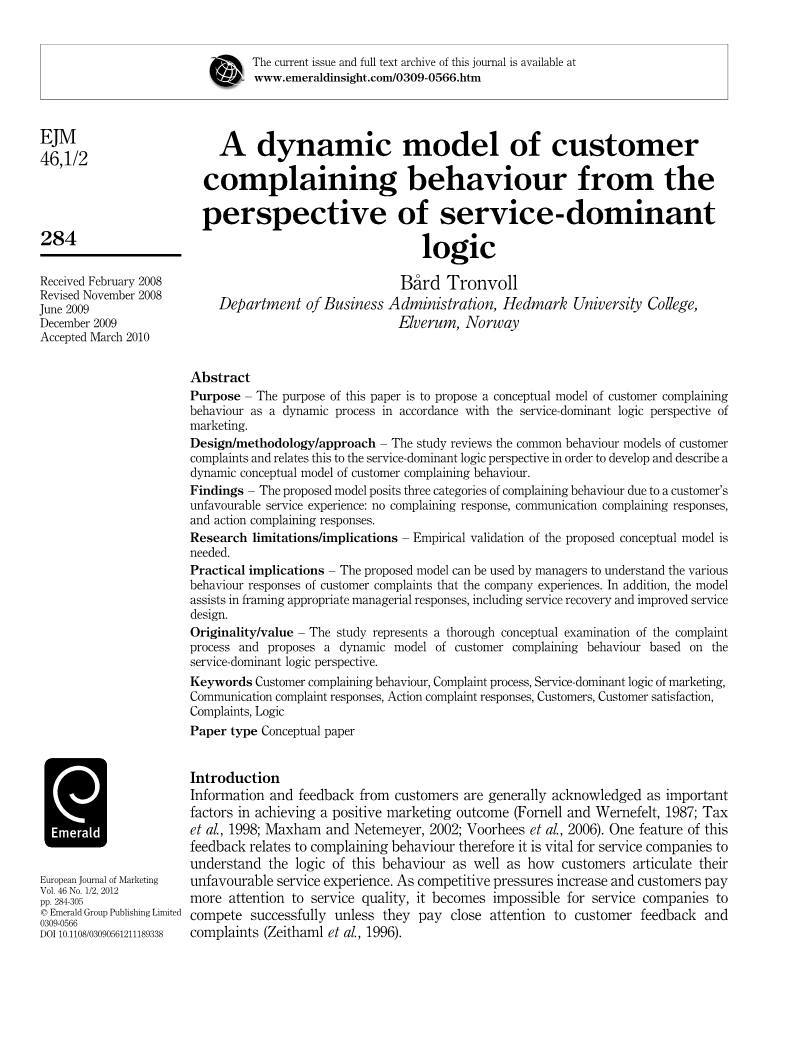

英语原文共 23 页,剩余内容已隐藏,支付完成后下载完整资料
A dynamic model of customer complaining behaviour from the
perspective of service-dominant logic
服务主导逻辑视角下的顾客抱怨行为动态模型
Ba˚rd Tronvoll
Department of Business Administration, Hedmark University College, Elverum, Norway
Abstract
摘要
Purpose – The purpose of this paper is to propose a conceptual model of customer complaining behaviour as a dynamic process in accordance with the service-dominant logic perspective of marketing.
目的—本文的目的是基于市场营销的服务主导逻辑视角,提出顾客抱怨行为动态过程的概念模型。
Design/methodology/approach – The study reviews the common behaviour models of customer- complaints and relates this to the service-dominant logic perspective in order to develop and describe a dynamic conceptual model of customer complaining behaviour.
设计/方法/路径-该研究回顾了顾客投诉的常见行为模型,并将其与服务主导逻辑视角联系起来,以便建立和描述顾客抱怨行为的动态概念模型。
Findings – The proposed model posits three categories of complaining behaviour due to a customerrsquo;s unfavorable service experience: no complaining response, communication complaining responses, and action complaining responses.
研究结果-拟建模型假定了三类由于顾客不愉快的服务体验而产生的抱怨行为:无抱怨响应,沟通抱怨响应和行动抱怨响应。
Research limitations/implications – Empirical validation of the proposed conceptual model is needed.
研究局限/影响--需要对拟建的概念模型进行实证验证。
Practical implications – The proposed model can be used by managers to understand the various behaviour responses of customer complaints that the company experiences. In addition, the model assists in framing appropriate managerial responses, including service recovery and improved service design.
实际意义-管理者可以使用拟建模型来了解公司经历的顾客抱怨的各种行为反应。此外,该模型还有助于构建包括服务补救和改进服务设计在内的适当的管理应答。
Originality/value – The study represents a thorough conceptual examination of the complaint process and proposes a dynamic model of customer complaining behaviour based on the service-dominant logic perspective.
创新性/价值-该研究对投诉过程进行了全面的概念性检验,并基于服务主导逻辑视角提出了顾客抱怨行为的动态模型。
Keywords:Customer complaining behaviour, Complaint process, Service-dominant logic of marketing, Communication complaint responses, Action complaint responses, Customers, Customer satisfaction, Complaints, Logic
关键词:顾客抱怨行为,投诉流程,服务营销主导逻辑,沟通投诉响应,行动投诉响应,顾客,顾客满意度,投诉,逻辑
Introduction
引言
Information and feedback from customers are generally acknowledged as important factors in achieving a positive marketing outcome (Fornell and Wernefelt, 1987; Tax et al., 1998; Maxham and Netemeyer, 2002; Voorhees et al., 2006). One feature of this feedback relates to complaining behaviour therefore it is vital for service companies to understand the logic of this behaviour as well as how customers articulate their unfavorable service experience. As competitive pressures increase and customers pay more attention to service quality, it becomes impossible for service companies to compete successfully unless they pay close attention to customer feedback and complaints (Zeithaml et al., 1996).
顾客的信息和反馈通常是实现积极的市场结果的重要因素(Fornell and Wernefelt, 1987; Taxet al.,1998; Maxham and Netemeyer,2002; Voorhees et al., 2006)。该反馈的特征之一与抱怨行为有关。因此,了解顾客如何表达其不愉快的服务体验以及理解此行为的逻辑对于服务公司而言是至关重要的。随着竞争压力的增加和顾客对服务质量重视程度的提高,服务公司必须密切关注顾客反馈和投诉才能竞争成功(Zeithaml et al.,1996)。
The successful resolution of complaining behaviour may significantly affect the financial performance of a company. A complaint provides an opportunity for service recovery followed by a chance to educate the customer, strengthen loyalty and evoke positive word-of-mouth comments (Reichheld and Sasser, 1990; Blodgett and Anderson, 2000; Shields, 2006). Although attracting new customers is vital, successful companies recognize that retaining current customers and building loyalty are even more important for profitability; as such, successful companies actually encourage dissatisfied customers to complain (Tax et al., 1998). Indeed, successful complaint handling can be a significant positive investment for a service company generating a return of 30-150 per cent on investment (Brown, 2000).
投诉行为的成功解决可能会对公司的财务业绩有明显的影响。投诉提供了服务补救、培养顾客,加强顾客忠诚度并引起积极的口碑评论的机会(Reichheld and Sasser,1990; Blodgett and Anderson, 2000; Shields, 2006)。虽然吸引新顾客至关重要,但成功的公司已经认识到保留现有顾客和建立忠诚度对盈利能力更为重要; 因此,成功的公司实际上会鼓励不满意的顾客去投诉(Tax et al., 1998)。事实上,成功的投诉处理对于服务公司来说是一项效益显著的投资,它可以产生30-150%的投资回报率(Brown,2000)。
Most existing models treat customer-complaining behaviour as a static, post-purchase phenomenon (Hirschman, 1970; Day and Landon, 1977; Richins, 1983a, 1987; Singh, 1988; Stephens, 2000). This retrospective view of customer complaining behaviour is derived from the conventional goods-dominant logic (G-D logic) of marketing. According to the G-D logic perspective, companies develop and offer products or services with embedded value for the customer after the exchange. Consequently, if a customer becomes aware of a product failure after the exchange, he or she will become dissatisfied and subsequently complain as a post-purchase activity. In contrast to this perspective, service-dominant logic (S-D logic) (Vargo and Lusch, 2004b; Lusch and Vargo, 2006b; Lusch et al., 2007; Vargo and Lusch, 2008) holds that service, defined as the application of resources linked to competence for the benefit of an actor, is the basis of economic exchange. Thus, S-D logic must be seen as a perspective where service as an exchange for service. According to this perspective, customers create value in a dynamic service-adjustment process (Tronvoll, 2007b). Thus, if they experience any lack of quality during this process of value creation, they may immediately give the company feedback, complain or voice their unfavorable experience to others. It follows that from an S-D logic perspective, complaints must be viewed as a behavioural process that occurs during the service process, in addition to being a post-interaction process as envisaged in existing models. From this perspective, the present stud
全文共80057字,剩余内容已隐藏,支付完成后下载完整资料
资料编号:[1811]
以上是毕业论文外文翻译,课题毕业论文、任务书、文献综述、开题报告、程序设计、图纸设计等资料可联系客服协助查找。


